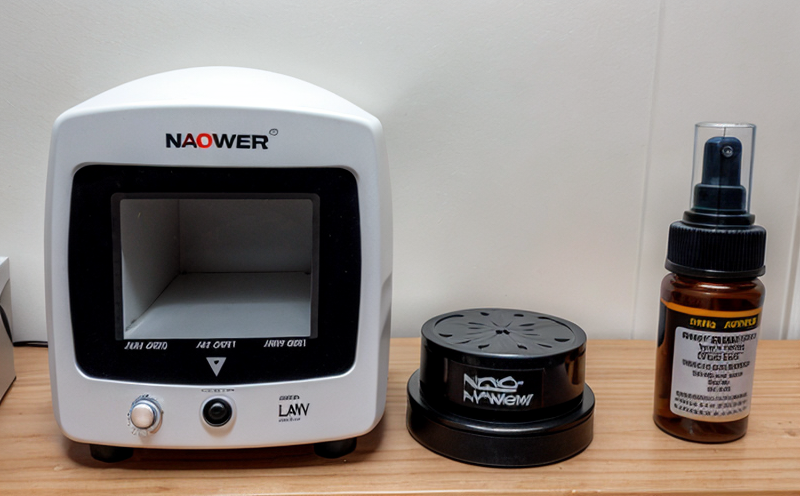ISO 22412 Dynamic Light Scattering Size Analysis of Nanoparticles in Suspension
The ISO 22412 standard provides a robust framework for the dynamic light scattering (DLS) size analysis of nanoparticles suspended in liquids. This method is particularly useful for characterizing the size distribution and stability of nanomaterials, which are crucial for ensuring product quality and compliance with safety regulations.
The technique relies on measuring the scattered intensity of laser light by particles in suspension as a function of angle and time. The scattering pattern provides information about particle size, polydispersity, and aggregation behavior. This non-invasive method is well-suited for analyzing nanomaterials because it can provide real-time data without altering the sample.
The dynamic nature of DLS makes it ideal for studying particles in suspension that are subject to Brownian motion. By measuring the intensity fluctuations over time, one can infer the hydrodynamic diameter of nanoparticles. The test is particularly valuable when dealing with complex samples where particle size distribution spans several orders of magnitude.
For accurate measurements, proper sample preparation is essential. This involves dispersing the nanopowders in a suitable solvent to form a stable suspension. Common solvents include water or various organic solvents depending on the nature of the nanoparticles. The suspensions are then filtered to remove agglomerates and ensure homogeneity.
The instrumentation used for this test typically includes a laser source, a detector array, and software capable of processing the scattered light data. Modern DLS instruments can provide detailed information about particle size distribution, including mean values, polydispersity indices, and volume fractions. These parameters are critical for understanding the stability and behavior of nanomaterials in various applications.
The test results must meet specific acceptance criteria defined by ISO 22412. These criteria include limits on the maximum acceptable percentage deviation from expected particle sizes and tolerances for polydispersity indices. Compliance with these standards ensures that the tested nanoparticles are consistent with their intended use.
By adhering to this standard, laboratories can provide reliable and reproducible data, which is essential for quality control, product development, and regulatory compliance. The method's precision and repeatability make it a preferred choice for both research and industrial applications.
Scope and Methodology
The scope of the ISO 22412 standard encompasses the measurement of hydrodynamic diameters of nanoparticles in suspension using dynamic light scattering. This method is applicable to a wide range of nanomaterials, including metal oxides, carbon nanotubes, quantum dots, and other engineered nanoparticles.
The methodology involves several key steps:
- Sample preparation: Dispersing the nanopowders in a suitable solvent to form a stable suspension.
- Suspension stabilization: Filtering the suspension to remove agglomerates and ensure homogeneity.
- Laser beam irradiation: Shining a laser through the sample and measuring the scattered light intensity.
- Data analysis: Processing the scattered light data using software to determine particle size distribution, polydispersity indices, and other relevant parameters.
The standard specifies detailed procedures for each step, ensuring that the measurements are consistent and reproducible. The results of this test can be used to characterize nanoparticles in various applications, such as drug delivery systems, cosmetics, and environmental remediation projects.
Compliance with ISO 22412 is essential for industries dealing with nanomaterials because it ensures that the particles are within acceptable size ranges and have predictable behavior. This standard provides a robust framework for quality control and product development in sectors like pharmaceuticals, cosmetics, and environmental engineering.
Why Choose This Test
The ISO 22412 dynamic light scattering size analysis of nanoparticles is a critical tool for ensuring the quality and safety of nanomaterials. Here are several reasons why this test is essential:
- Precision and Repeatability: The method provides precise, repeatable measurements of particle size distribution, making it ideal for quality control.
- Real-Time Data: Dynamic light scattering allows for real-time monitoring of particle behavior in suspension, which is particularly useful for studying agglomeration and stability over time.
- Versatility: This test can be applied to a wide range of nanomaterials, including metal oxides, carbon nanotubes, and quantum dots.
- Regulatory Compliance: Adherence to ISO 22412 ensures that the tested nanoparticles meet industry standards and regulations.
- R&D Support: The method provides valuable insights into nanoparticle behavior in suspension, which is crucial for product development.
- Safety Assessment: By ensuring particle size consistency, this test helps prevent potential health risks associated with poorly characterized nanomaterials.
In summary, the ISO 22412 dynamic light scattering size analysis of nanoparticles in suspension is a versatile and precise method that supports quality control, product development, and regulatory compliance across various industries.
Use Cases and Application Examples
- Pharmaceutical Industry: Ensuring the stability of drug delivery systems that rely on nanoparticles for targeted drug release.
- Cosmetics Sector: Characterizing the size distribution of nanoparticles used in sunscreens or other topical products to ensure efficacy and safety.
- Environmental Engineering: Studying the behavior of nanoparticles in water purification processes to optimize performance and efficiency.
- Semiconductor Industry: Analyzing the size distribution of nanoparticles used in manufacturing processes for integrated circuits.
- Toxicology Studies: Evaluating the potential risks associated with nanomaterials by assessing their stability and behavior in various environments.
- Metal Oxide Nanoparticles: Characterizing metal oxide nanoparticles to ensure they meet specific size requirements for catalytic applications.
The versatility of this test allows it to be applied across multiple industries, ensuring that nanomaterials are characterized accurately and consistently. This precision is crucial for maintaining product quality and safety while complying with industry standards.





